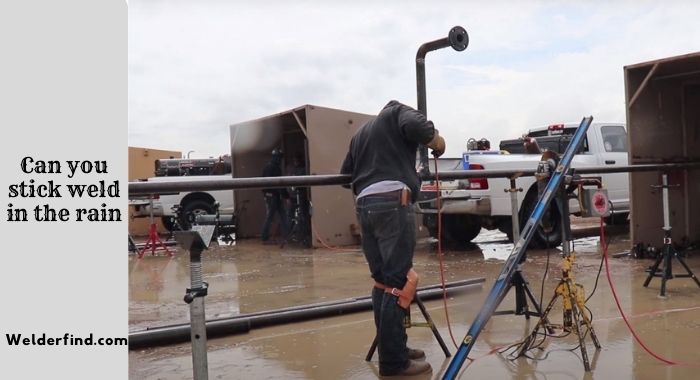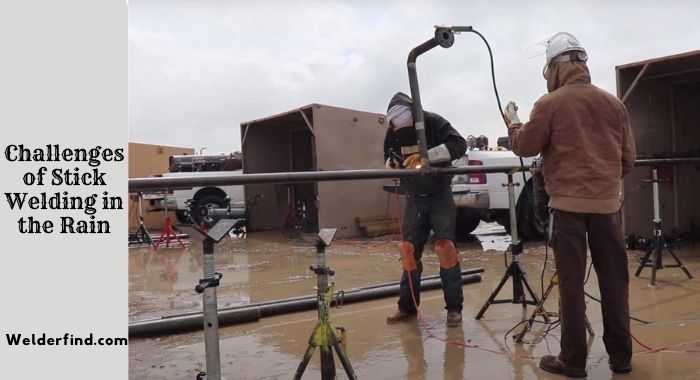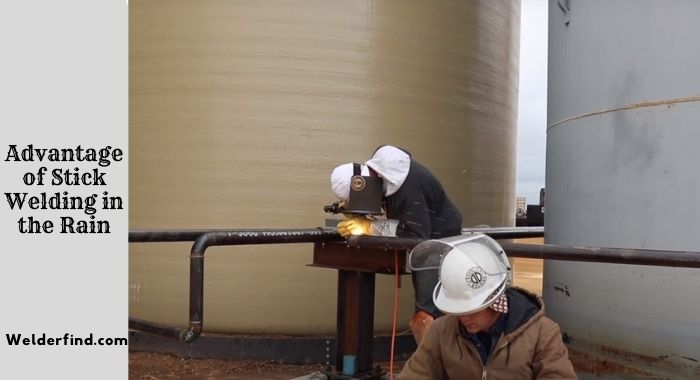Stick welding is a unique process that is completed by melting metal with the help of an electric metal arch. Electricity and rain are contradictory, so can you stick weld in the rain?
All electric-based tasks are risky in rainy conditions. If you badly needed to do stick welding in the rain then the best recommendation is to use a shed in the welding area, wearing protective clothes and maintaining precautions.
In this guide, we will discuss whether you can stick weld in the rain, the challenges of stick welding in the rain and what to focus on when stick welding in the rain. You will also know the advantages and disadvantages of stick welding in the rain.
Can you stick weld in the rain?

Yes, you can stick weld in the rain. When the rain starts in the mid-time of stick welding, you can’t stop the process without completing it. Good to know that rain has not significantly impacted stick welding. A flux-coated electrode is used in stick welding, producing a white-hot expanding gas cloud surrounding the welding area.
This causes the welding area to become so hot that the surrounding rainwater turns into steam. And the steam creates a dry space to allow the metal to melt in the rain. Therefore, stick welding in the rain is a possible task.
However, you might get rust, condensation, mud and ice on the metal you weld. But high amperage stick weld models can melt all dust contaminates and help to join two metals strongly.
Challenges of Stick Welding in the Rain

Let’s know some challenges you face with stick welding in the rain.
Excess moisture
Rain means adding moisture to the electrode’s flux coating and welding area. Excess moisture causes the weld metal to absorb hydrogen, which negatively affects welding quality, like cracking or defects.
Besides, moisture condition reduces the shielding power of any welding.
Stability of electrode
The rainwater is responsible for instability in the welding electrodes that disrupt the electrical conductivity. As a result, the arch performance may canker.
Gas Disruption
Poor gas coverage may occur from the added moisture from rain. The poor gas flow reduces the gas flow in the shield. It also can cause porosity and weld spatter in stick welding.
Visibility defects
The falling rainwater on the helmet visor can impair the worker’s eye and create obstacles to seeing the welding joint.
Electrical Hazards
Getting shocked is a very common incident in welding in rainy conditions. The shocking risk increases in wet conditions when welding. Besides, operating a welding machine in the rain is more challenging.
Safety issues
Rain is responsible for making your welding area slippery. The slippery surface can lead you to fall or slip on the surface.
Flux Coating
spattering, inconsistent are two common incidents to weld in the rain. So, maintain tricking and arch behavior in the rainy condition.
What to focus on when stick welding in the rain?
Focusing on some key factors is important when stick welding in the rain.
Keep electrode dry
It is recommended to store the stick welding electrodes in a sealed packet. Always protect the electrode to keep them dry because moisture-contaminated electrodes can lead to defects in welding.
Choose electrode
Choose especially-made electrodes that are rainproof. Besides, you can use electrode that have great moisture absorption power. It helps to prevent a negative impact on welding.
Dry the electrode before using
Drying the electrode in the oven at recommended temperature removes moisture from the flux coating. But remember not to dry them with excess heat. Overheating can ruin the quality of the electrode.
Control the arc stick
Be careful to choose the right pressure and stability when using arch stick. Perfect arch length and stability ensure the best welding.
Maintaining Angle and Travel Speed
If the angle and travel speed is ok then you will get a smoother and precise surface after welding.
Ensure better visibility
A clear visibility is helpful to stick weld in the rain. Without transparent visibility your welding task might be defective.
How to safeguard yourself while Stick welding in the rain
It is important to maintain some precautions while stick welding in the rain. Otherwise, you may face several potential hazards.
- Wear waterproof clothes to protect your body from water, cold and moisture. Ensure that your arms, necks and legs are properly covered with the cloth. A rain poncho or jacket is the best option for this task.
- Use a welding helmet and safety goggles to protect your face and eyes from raindrops and welding heat.
- Use specially insulated hand gloves to retain a grip on the tools and avoid wearing wet gloves.
- Wear waterproof, slip-resistant and insulated boots to prevent falls on slippery surfaces.
- Use a respirator to be safe from fumes and gases created by the welding.
- Wear PPE if possible because wearing a PPE can support you for whole body
- Ensure the electricity system is correctly grounded to prevent the potential risk of shock.
- Making a temporary shelter or canopy to protect the welding tools and workspace is good.
- Keep a special plan for dealing with emergencies. Make sure about the support and safety when you will fall any accident.
Advantages of stick welding in the rain

Stick welding in the rain has some potential hassle and risk. But this also has some great advantages.
- Rain can spread the heat from the welding area. As a result, the working tools will be safe from overheating and distorting.
- Due to the cold environment of rain, your welding will go through improved weld penetration and fusion.
- The rainy weather helps cool the slag layer of the welding.
- The added moisture can help to reduce the risk of arc flash.
- Added moisture also provides better arch stability.
- Stick welding on rainy days reduces cracks and provides a smoother welding surface.
Last Words
We hope you can stick weld in the rain. The straightforFward answer is yes, you do it with proper caution. Since electricity and rain are contradictory so there have some potential risks.
But maintaining safety tips can help you do the task effectively and protect yourself. Must keep some support for emergency situation.
